German Shepherd dogs are a joy to own. They’re excellent companion dogs, have lots of energy, and are quick learners.
As a first-time German Shepherd owner or someone who’s thinking about bringing a German Shepherd into your home, you likely have many questions.
That’s why we created Anything German Shepherd.
We’re enthusiastic German Shepherd owners who share our first-hand knowledge and passion with you so that you spend less time learning the ropes of German Shepherd ownership and more time cuddling with your new family member.
If you came here with a specific German Shepherd topic in mind, click on the appropriate link below to get started.
Otherwise, if you’re itching to learn as much as you can about German Shepherds, scroll down for a thorough walk-through of each of these topics.
German Shepherd Breed Information
The German Shepherd Dog (called GSD in the German Shepherd world) has its origins in Germany. Since German Shepherds look similar to wolves, many people assume they were one of the first dog breeds.
Surprisingly, GSDs are actually fairly modern dogs, having their origins in the late 1800s.

Germans bred German Shepherds to be working dogs. They primarily used them for herding sheep.
Nowadays, German Shepherds serve humans in several other ways, including search-and-rescue, police support, and disability assistance.
Of course, many people own German Shepherds for the pure joy of having a loving and protective four-footed companion.
Physical Characteristics
Most people can identify a German Shepherd dog walking down the street. But in case you’re unsure what they look like, below are the tell-tale signs of a purebred GSD.
- Medium to large size (stands 22 – 26 inches tall)
- Coat ranges from a tan and black color to a red and black color
- Black saddle or blanket over their back and black face masks
- Domed forehead and square muzzle
- Large, erect ears
- Bushy tail
A German Shepherd’s coat is another noteworthy characteristic of interest. They have a double coat with either medium or long hair.
GSDs most commonly have medium hair coats (which people also call standard or short-haired).
In fact, it wasn’t until 2010 when the FCI (International Canine Federation) recognized long-hair German Shepherds as having a recessive gene and belonging to the GSD category.
Therefore, if you’re working with a breeder, you may hear them use “Variety A” and “Variety B,” representing medium-hair and long-hair GSDs, respectively.
Color Variations
Although the two-tone tan and black or red and black are the most common color patterns on German Shepherd dogs, genetics can sometimes offer surprises.
Examples of purebred German Shepherds born with unique markings include:
- Pure black
- Pure white
- Silver
- Blue
- Sable
- Liver
If you’re interested in showing your GSD, it’s critical to understand these color variations. That’s because you can usually show a sable or entirely black German Shepherd.
However, blue, liver, and white GSDs typically aren’t permitted.
German Shepherd Breed Mixes
Whether you adopt a dog with German Shepherd blood in it or are seeking the protective qualities of a GSD with a mix of kid-friendly genes, there’s no shortage of German Shepherd mixed dogs available.
Some examples include:
- German Shepherd and Golden Retriever
- German Shepherd and Chihuahua
- German Shepherd and Rhodesian Ridgeback
Some breeders even mix German Shepherds with wolves. Yes, you read that right—the wild animal that would gobble up your cat or small dog!
Further Reading
If you’re interested in learning more about the German Shepherd breed, check out these posts we put together.
Whether you’re curious about the difference between German Shepherds and other dog breeds or are looking for another breed to be a companion for your GSD, we’ve got you covered.
- 16 Adorable Dogs That Look Like German Shepherds
- Best Companion Dog for German Shepherd
- Do German Shepherd Puppies Change Color?
- DDR German Shepherd: Everything You Need to Know
- German Shepherd vs. Rottweiler: 20 Differences You Should Know
- The Unusual Silver German Shepherd: What Should You Know?
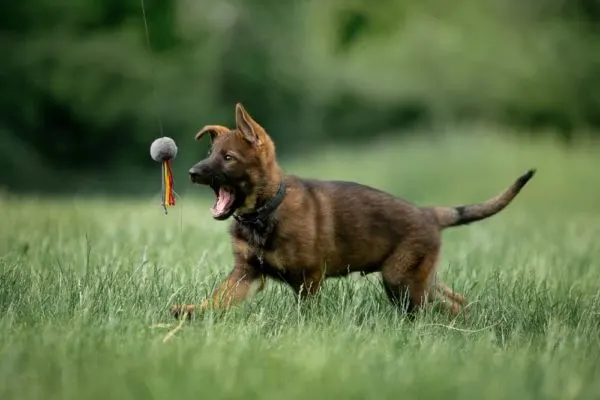
German Shepherd Puppies Information
Is there anything cuter than a German Shepherd puppy? Perhaps eight of them, which is a GSD’s average litter size.
You might even get lucky and see as many as 15 GSD puppies at once because German Shepherds are notorious for having large litters.
Development Stages of a German Shepherd Puppy
If you adopt or buy a German Shepherd puppy, you’ll likely feel that their small, extra-cute phase passes too quickly.
Yet, German Shepherds don’t actually reach maturity until two or three years old—your furniture-turned-chew-toys can likely attest to that!
So, if you’re wondering about the development stages of a German Shepherd puppy, we’ve got you covered.
0 – 2 Weeks Old: During this newborn phase, your German Shepherd puppy will be blind, deaf, and depend on its mother’s milk because its teeth haven’t developed yet.
It’ll also rely on the body heat from its littermates to stay warm.
2 – 4 Weeks Old: Your German Shepherd puppy will develop its senses and interact with the world. It’ll recognize humans and other dogs, thanks to its eyes and ears opening up.
Your puppy will get playful with other puppies and become more independent.
4 – 8 Weeks Old: The time when German Shepherd puppies become even more social and bond with people and other dogs.
They have a full set of puppy teeth and may go through a stage of being afraid of unfamiliar things.
8 Weeks – 6 Months: German Shepherd puppies eat solid food and begin teething. By three months old, they usually have their front teeth, followed by the back teeth by six months of age.
During this time, your GSD’s ears will go through the comical process of changing from floppy to standing up.
6 Months – 2 or 3 Years: At this point, your German Shepherd isn’t so much a puppy but an adolescent.
By the time your GSD reaches 15 – 18 months old, you should give them adult dog food, following your veterinarian’s recommendation.
By the time your GSD reaches 18 months old, it’ll have a longer attention span. Therefore, it’s a great opportunity to sign them up for a more rigorous obedience class.
Bringing Home a German Shepherd Puppy
We understand the temptation to bring home your German Shepherd puppy at a young age. After all, every day that passes is more time where they don’t get to bond with you.
Nevertheless, experts advise waiting until your GSD puppy is between eight and 12 weeks old before you take your puppy away from its mom. There are a few reasons for this, including:
- Your puppy’s mom trains him.
- By spending time with its siblings, your puppy will learn important socialization skills.
- Cases of anxiety, barking, and biting tend to be higher in puppies taken away from their moms at too young of an age.
Potty Training
When your German Shepherd puppy is five or six weeks old, it’ll begin venturing away from its mom and, as a result, may use your floor as its restroom.
Typically, you’ll have to make do with these accidents until your puppy reaches around seven to eight weeks of age—that’s when GSDs become potty trainable.
Having patience and using positive reinforcement techniques during the potty-training stage is critical for success.
Also, be prepared to let your German Shepherd puppy outside often, for it can take them up to six months before they gain full bladder control.
Further Reading
Do you have more questions about German Shepherd puppies? If so, take a look at the articles below to learn more about helping your pup grow into a healthy and happy adult.
- How Much To Feed A German Shepherd Puppy For Best Results
- What Is the Best Length of Time I Should Walk My GSD Puppy?
- When Do German Shepherds Lose Their Puppy Teeth?
- 6-Month-Old German Shepherd: What to Expect as Your GSD Puppy Gets Big
- Why Does My German Shepherd Puppy Drink So Much Water?
- When Do German Shepherd Puppies Open Their Eyes?
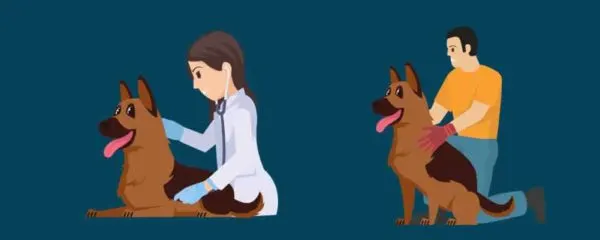
German Shepherd Health/Care Information
As a loving German Shepherd owner, keeping your four-footed family member healthy is no doubt a priority to you.
You know the basics like daily feedings and making sure your GSD always has access to water, but when it comes to the nitty-gritty health items, you might feel lost.
If so, rest easy. Overall, German Shepherds are low-maintenance dogs. However, if you notice that your German Shepherd’s health seems off or have questions about their general care, we’re here to help.
How Often Should You Take Your German Shepherd to the Veterinarian?
Assuming that your German Shepherd dog is in good health, the frequency with which you take it to the veterinarian varies depending on its age.
Humane societies recommend bringing German Shepherd puppies to the vet every three to four weeks until they reach four months of age.
The reason being is that they’ll need frequent vaccinations during that time, and your veterinarian will be able to monitor your puppy for common diseases.
Once your dog turns one year old, a yearly trip to the vet is usually all they need.
During these annual check-ups, your veterinarian will perform a routine physical, inject any booster vaccines needed, and may run some blood work.
They’ll also prescribe you anti-tick, flea, and parasite medication, depending on where you live.
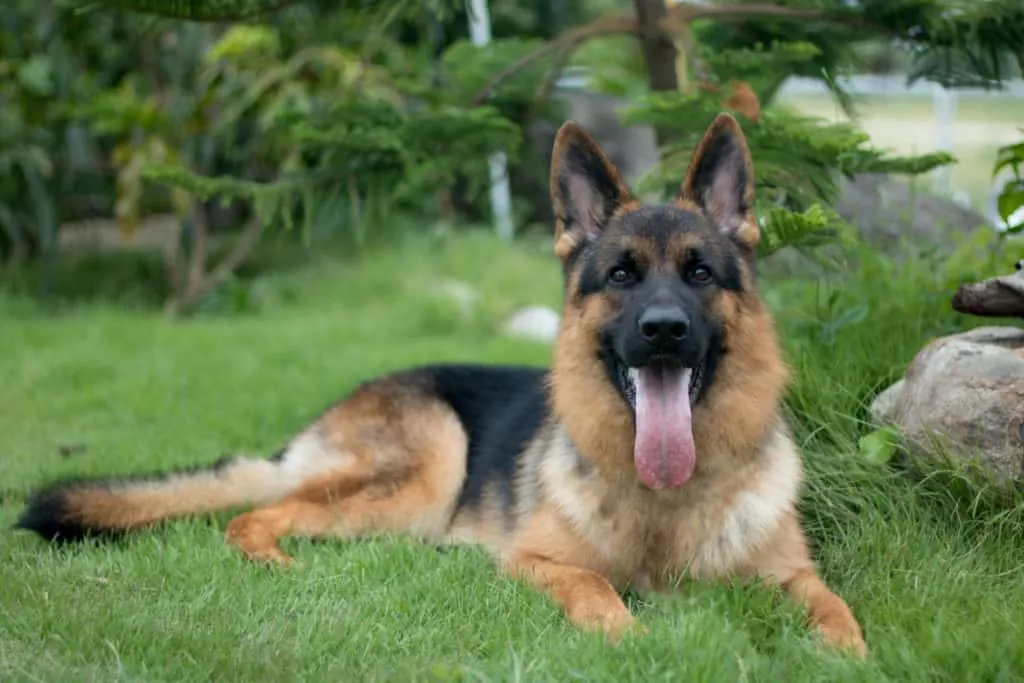
Common Health Issues in German Shepherds
German Shepherd dogs are hardy, but it doesn’t mean they’re immune to health issues. Below are some common conditions that your GSD might face.
Skin Issues: German Shepherds often fall victim to allergies resulting from bacteria, fungus, or pollen, among other irritants. Parasites or pests like fleas can also cause skin problems.
Hip Dysplasia: The hereditary-based condition of hip dysplasia often doesn’t make its appearance until a GSD is an adult. It results when the hip bone and socket form irregularly.
The good news is that if you take your German Shepherd to its routine vet visits, your veterinarian will be able to identify and suggest treatments for hip dysplasia.
Ear Infections: Did you know that 20% of dogs will likely experience ear infections at some point in their lives? Luckily, a German Shepherd’s pointy ears make them less susceptible to this issue.
Nevertheless, you should thoroughly dry your GSD’s ears after they swim or take a bath to prevent an ear infection.
Best Grooming Practices
Here’s something that can be hard for new GSD owners to come to terms with: German Shepherds have as much love in their hearts as they do hair that they shed.
Therefore, it’s critical that you make grooming a routine part of your GSD care.
You should aim to brush your German Shepherd a minimum of three to four times per week.
Not only will brushing your GSD make their fur soft and shiny, but it’ll prevent it from becoming matted, which is an uncomfortable and health-threatening issue for your dog.
Bathing your German Shepherd is another important grooming practice. Of course, it’s possible to go overboard; bathing your GSD too much can dry out its skin.
Therefore, we recommend aiming to bathe your German Shepherd dog once a month.
How to Brush A German Shepherd Like a Boss & Handy Tools For Grooming
Because German Shepherds have such thick coats, grooming is essential to keep your dog’s fur from matting, creating further health issues.
Furthermore, German Shepherds have two coats; a topcoat that acts as a guard with thick, coarse hair and an undercoat that is thick and soft.
Shepherds shed year-round, so it’s important to brush them three to four times a week. However, they also have two heavy shedding seasons; spring and fall.
During these seasons, you should prepare for your dog to shed a ton of hair and increase your brushing routine to at least 10 minutes per day.
Not only does grooming your dog create a time to bond together, but it also keeps their coat healthy, increases airflow to your pup in hotter months, and distributes natural oils produced by the skin.
If you want to prepare yourself for these heavy grooming seasons, or if you’re just looking for a great tool to help you meet the grooming needs of your pup, the BV Dog Brush is an excellent option.
This two-sided brush offers an ergonomic handle that makes brushing your pup convenient and pain-free. The brush contains thick bristles on one side and round tip pins on the other for versatile use.
The thick bristles can help remove dirt and loose hair, while the efficient pins can detangle and help distribute natural oils from your dog’s skin, leaving its coat smooth and shiny.
If you’d like to add a little extra ease to your grooming routine, you can try out the Burt’s Bees for Dogs Natural Dog Detangling Spray; a gentle, PH balanced detangling spray made from all-natural ingredients.
Why LuckyTail Is The Best Nail Grinder On The Market
| LuckyTail Nail Grinder | Visit LuckyTail Website | Check Price On Amazon |
|---|---|---|
 | LuckyTail.com | Amazon.com |
Further Reading
Your German Shepherd is a family member. So, take a look at the following articles to learn more about health issues they may encounter and general care tips to keep them in tip-top shape.
- 3 Common German Shepherd Tail Problems to Be Aware Of
- Why Is My German Shepherd Scratching So Much: Skin Issues That Plague GSDs
- When Do German Shepherds Stop Teething? How to Recognize & Help
- When Do German Shepherd Tails Get Bushy: The GSD Tail Tale
- Can You Shave Your Shepherd Dog and When Should You?
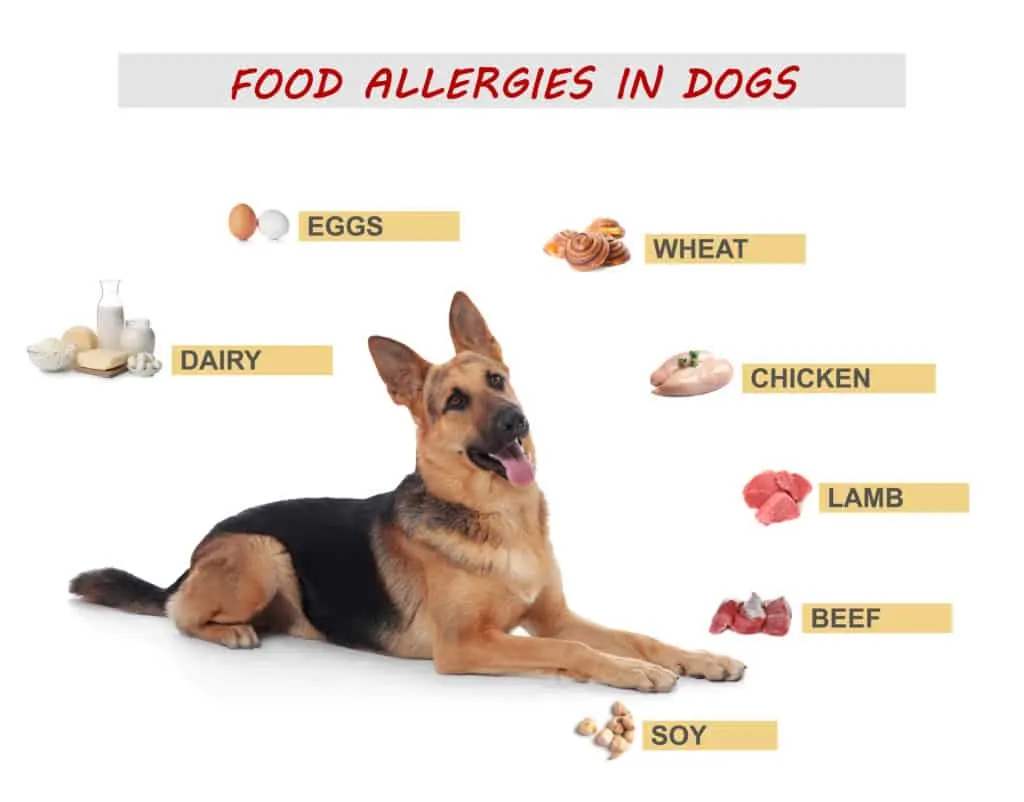
German Shepherd Nutrition Information
A well-balanced diet is vital for setting your GSD up for a long and healthy life.
The National Academies Press breaks down how many calories, crude protein, and fat your German Shepherd should have during the different phases of its life.
Just like humans, balancing your GSD’s nutrition promotes a healthy weight and well-functioning organs.
When searching for dry or wet food for your German Shepherd dog, you should choose an option that has the following as its main ingredients:
- Meat
- Vegetables
- Grains
- Fruits
If your first instinct is to believe that anything but meat on the list above is a filler, you’re not alone. However, while a dog’s preferred food is meat, they’re actually an omnivore.
Therefore, they can and should extract essential vitamins, minerals, and fiber from vegetarian ingredients.
Wet Food vs. Dry Food
As much as you want the best for your German Shepherd, everyone’s wallet has a limit, and that limit often comes into play when choosing wet or dry food.
Here’s some good news: Your dog can get just as good nutrition from dry food as it does from wet food.
There’s no doubt about it—your GSD will be more enthusiastic about lapping up canned food than if they’re presented with a bowl of dry kibbles.
Aside from its tastier properties, wet food is beneficial for German Shepherds with urinary issues, as it helps them stay hydrated.
Nevertheless, for the vast majority of GSDs, feeding them high-quality dry food is an excellent way to give them a well-balanced diet.
Understanding Dog Food Labels
Regardless of whether you choose the canned or dry food route, it’s important to understand the wording on dog food labels.
If you see the word “dinner” as part of the label, it’s an indication that the “main” ingredient they promote on the front of the package only makes up about 25% of that food.
On the other hand, if a brand leads with the name of the ingredient on the front of the label, such as “duck and sweet potato,” then you can expect it to contain up to 95% of those ingredients.
Finally, make sure the dog food you buy contains a statement from the Association of American Feed Control Officials.
They assess if the food has the minimum amount of nutrients and energy required for your German Shepherd to live a healthy life.
Foods You Should Keep Out of Reach of Your German Shepherd
A part of German Shepherd care is knowing what not to do as much as knowing what to do. So, to avoid a sudden trip to the vet, make sure to keep your GSD away from the following items.
- Chocolate: Can cause kidney failure.
- Onions, garlic, and chives: Instigates gastrointestinal irritation.
- Corn on the cob: Corn itself isn’t dangerous, but pieces of the cob can block your GSD’s intestine.
- Avocado: GSDs react with diarrhea and vomiting.
- Grapes: Cause liver damage and kidney failure (raisins have the same effect).
That’s just a “taste” of the foods you should never feed your German Shepherd. For a more extensive list, check out the ASPCA’s recommendations.
Further Reading
Proper nutrition is critical for the wellbeing of your German Shepherd. To learn more about how you can keep your German Shepherd healthy, check out our following most visited nutrition-related articles.
- What Can German Shepherds Not Eat: Never Feed These 12 Foods to Your GSD
- How Long Can a German Shepherd Go Without Eating: When to Worry If Your GSD Stops Eating
- Why Is My German Shepherd So Skinny? How Do I Fatten Her Up?
- Can German Shepherds Eat Peanut Butter? Find Out If This Treat Is Safe for GSDs
- Can German Shepherds Eat Bananas: How GSDs Can Enjoy This Sweet Treat Safely
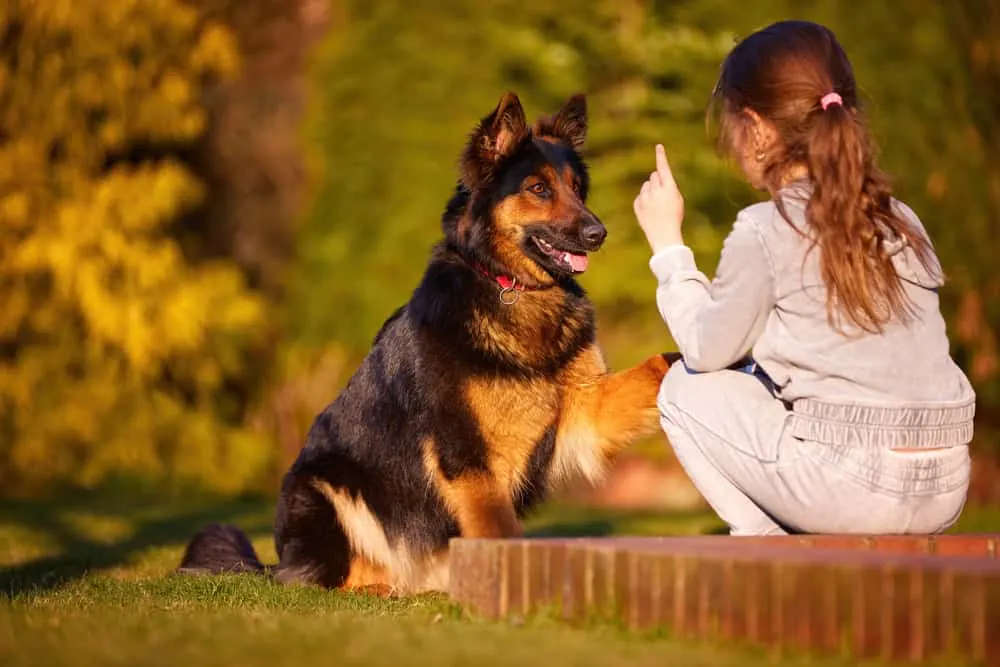
German Shepherd Behavior Information
Anyone who owns a German Shepherd can attest to how loving and loyal they are; breeders bred them to be watchdogs and fiercely loyal to their owners.
But as a result, German Shepherds have a reputation for being aggressive—a parent often holds their child back from running up to an unfamiliar German Shepherd while having no problem with their kid pulling at the ears of an unfamiliar Golden Retriever.
A German Shepherd’s protective instinct is a wonderful quality under the right circumstance.
It means that they have the fearlessness and confidence to serve as police and rescue dogs, and they make excellent watchdogs for protecting private properties.
However, it also means that unless you expose them to strangers and other dogs at a young age, they may display aggressive tendencies at inappropriate times.
For this reason, GSD owners must make it a priority to socialize their German Shepherd at a young age.
Common GSD Behavior Problems
No matter how much you love your German Shepherd dog, there may come a time when you need to address a behavior problem, especially if you’re raising a puppy.
Below are some of the most common problems you may encounter:
- Digging
- Barking
- Biting or nipping
- Jumping on furniture
- Displays of dominance
- Aggression/Protectiveness
Of course, these behavior problems aren’t exclusive to German Shepherds. Furthermore, behaviors like nipping often go away as your GSD grows.
In the next section, we’ll discuss how to use positive reinforcement training methods to address these behavior problems.
Understanding Dominance and Hyperactivity
German Shepherds love being the alpha, as this is what instinct instructs them to do.
Yet, many owners mistake their alpha behavior as a sign of hyperactivity instead of seeing the situation for what it is—dominance.
Signs that your German Shepherd dog is dominant instead of hyperactive include:
- Placing its paws on you
- Growling if you go near its food
- Jumping or lunging at people
- Distaste for using a leash
- Going out the door before you do
Above all, it’s important to keep this in mind: Dominance is never your GSD’s fault.
Targeted breeding tactics made German Shepherds territorial, and their environment either encourages or discourages such behavior.
The bottom line is if you obey your German Shepherd more than he obeys you, you’re encouraging him to be dominant.
Separation anxiety is a GSD behavior problem that tugs at many owner’s heartstrings—we all love our dogs, and it pains us to see them distressed because of our absence.
German Shepherds feel two primary emotions when it comes to separation anxiety: Stress and anxiousness.
Signs that your GSD is showing signs of separation anxiety behavior include:
- Constant barking
- Chewing on furniture
- Tearing down curtains and other hanging objects
- Injuring itself in an attempt to get out of the house
Further Reading
For more details on German Shepherd temperaments and how to handle behavioral concerns, take a look at these articles we put together.
- At What Age Will Your GSD Dog First Get Aggressive?
- Is It Good to Have Two German Shepherds: Here’s What You Need to Know
- Why Do German Shepherds Groan: GSD Vocalizations and What They Mean
- Are German Shepherds Good with Babies?
- Why Are German Shepherds Aggressive: A Complete Guide
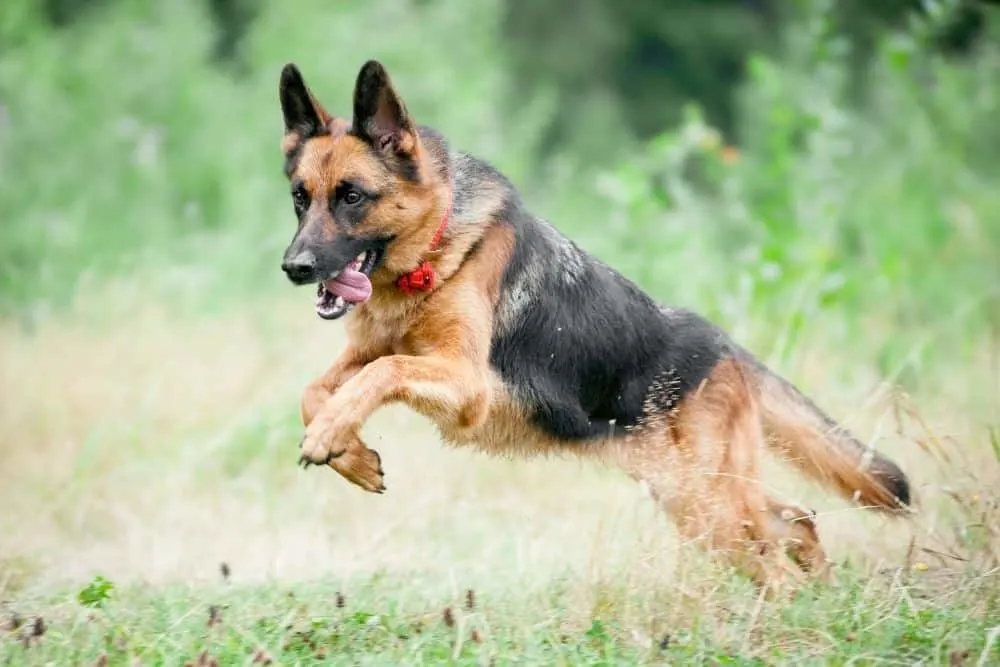
German Shepherd Training Information
Training is crucial for your German Shepherd’s wellbeing. You’ve likely heard that kids need and want boundaries; it’s the same for GSDs.
The good news is that German Shepherds are intelligent and eager to please, making it a rewarding process to train them.
Commands German Shepherds Should Learn
It’s easiest to train your GSD as a puppy, but even if you welcome an adult dog into your family, you can teach an old dog new tricks (it just might take longer).
In fact, according to research, dogs can learn over 150 words—far more than the sit and stay commands most GSD owners use.
So, as you work on training your German Shepherd, below are some must-teach commands:
- Come
- Leave it
- Go potty
- Settle
- Wait
Of course, you can use any words you like for these commands, and that’s especially important if your GSD’s name resembles any of them.
The last thing you want is your dog to think you’re calling its name when you’re actually using a word to reprimand him!
Importance of Positive Reinforcement
Positive reinforcement is the concept of using treats, praise, playtime, and anything else your German Shepherd loves as a reward for doing something you asked.
While it’s okay and necessary to use a firm tone when your GSD does something bad, you should never reprimand your dog for not following commands when training—it’ll make them afraid of you and the training process.
The good news is that German Shepherds are people pleasers. When you first use positive reinforcement when training them for a specific command, they likely won’t understand what they did to get the reward.
So, it’ll take some guessing on their part. However, before long, they’ll connect the word with the action you want from them.
How to Wean Off Treats
Treats are the most common form of positive reinforcement GSD owners use. But too many treats aren’t good for your dog’s health, and carrying a bag of treats with you everywhere you go isn’t practical.
So, try implementing these strategies for weaning your German Shepherd off excessive praise every time you ask them to sit or lie down:
- Give them a treat every other time they follow your command. Then cut that back to every three times, and so on, until you only give them a treat on occasion for doing what you ask.
- Use positive words as you give the treat, such as “good girl.” That way, even when you’re not offering a treat, they’ll still recognize the praise.
- At first, your praise should be over-the-top enthusiastic. As time progresses, you’ll be able to reduce the excessive enthusiasm while still using a positive, upbeat tone.
Further Reading
If you’d like more information about training your German Shepherd dog, we’ve put together an extensive collection of training guides.
Click on the following links to read some of our most popular training resources.
- How to Train a German Shepherd Husky Mix Puppy: What They Really Need
- German Shepherd Training Commands: Common Commands Your GSD Needs to Learn
- What Is the Best Way to Train Your German Shepherd for Personal Protection?
- How to Train a German Shepherd to Attack: Learn the Basics of Protection
- How to Perfectly Train Your 8 Week Old German Shepherd Puppy: The Ultimate Guide for Beginners
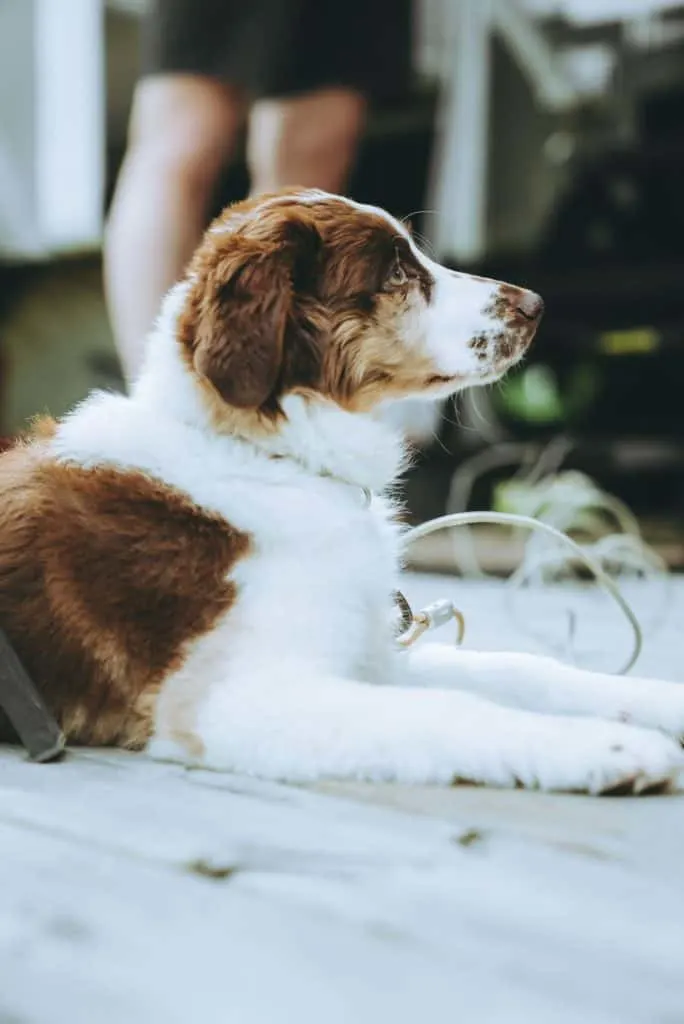
How Shepherd Breeds Have Become The Most Popular Pet Dogs
Related Shepherd Breeds (Australian Shepherd, Belgian Malinois, Dutch Shepherd)
The term “Shepherd” is a general word to describe any dog that people breed to herd.
Although most people think of German Shepherds when they hear “shepherd,” there are three breeds similar to the German variety.
They include Australian Shepherds, Dutch Shepherds, and the Belgian Malinois.
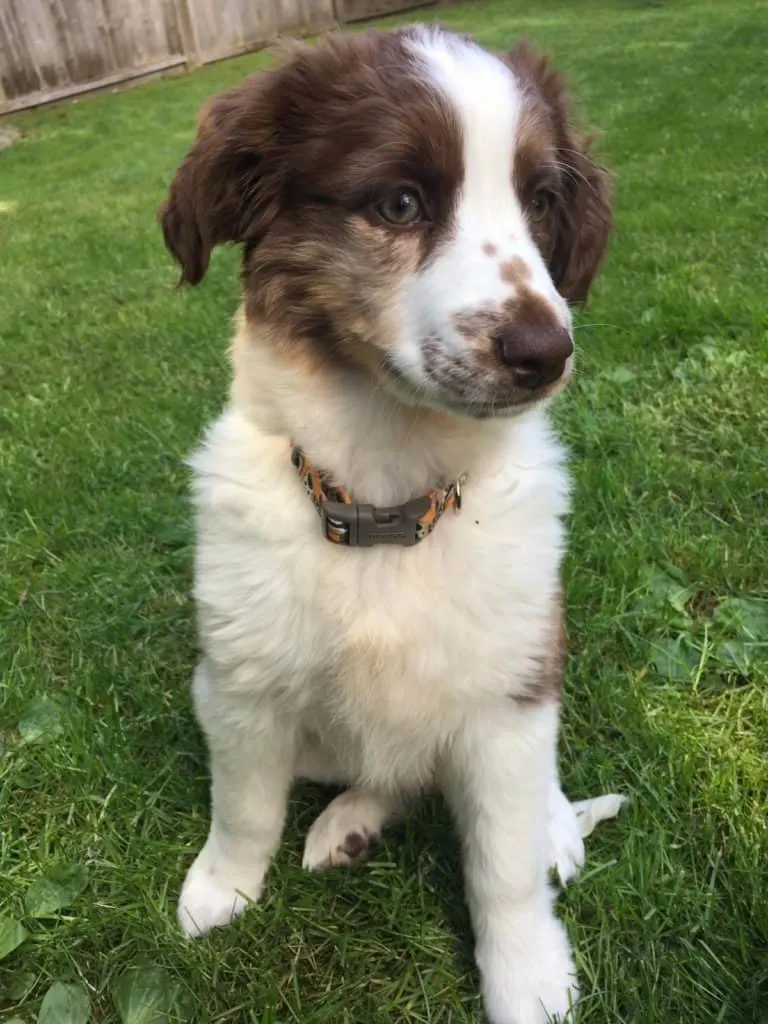
Don’t let its name fool you—the Australian Shepherd has its origins in the United States, not Australia. They’re hardy dogs that farmers commonly use on their ranches.
Australian Shepherds have a multi-colored coat, often with a merle design (red and grey mottled pattern).
They’re quick learners and high strung, so they do best with owners who give them active jobs to complete.
If you’re interested in bringing home a mixed dog with Australian Shepherd blood, you’ll have many options to choose from, including:
- Australian Shepherd and German Shepherd
- Australian Shepherd and Great Pyrenees
- Australian Shepherd and Greyhound
- Australian Shepherd and Mountain Cur
Further Reading
Are you still trying to decide if an Australian Shepherd is a good breed to welcome into your home? If so, our articles below can help you out.
- When Does an Australian Shepherd Stop Growing? What to Expect as Your Aussie Grows Up
- Australian Shepherd Goldendoodle Mix: The Hard-Working Dog With a Heart of Gold
- 14 Eye-Opening Differences Between Australian Shepherds and German Shepherds
- Are Australian Shepherds a One Person Dog: Why Aussies Tend to Play Favorites
- Australian Shepherd Labradoodle Mix: Meet the Smart, Sensitive Aussiedoodle Dog

Hailing from Europe, the Dutch Shepherd is a farm dog with the stamina to work in the fields all day herding animals.
Like the German Shepherd, many people now use this dog breed for search and rescue and other police work.
The Dutch Shepherd has a double coat with hair that ranges from short to long, depending on its genes.
Dutch Shepherds have primarily golden or chestnut red coats and black accents. Often, they have black masks like German Shepherds.
Breeders mix Dutch Shepherds with German Shepherds, along with several other breeds, including:
- Border Collies
- Belgian Malinois
- Huskies
- Pit Bulls
Further Reading
If you’re still trying to wrap your head around the Dutch Shepherd breed and how they compare to German Shepherds, the articles below will help clear things up.
- Dutch Shepherd vs. Belgian Malinois: Both Brave, Smart—But Which is Right for You?
- German Shepherd vs. Dutch Shepherd: An In-Depth View of Kindred Cousins
- Dutch Shepherd Belgian Malinois Mix: Meet the Sturdy, Serious, Hard-Working Dutch Malinois
- Dutch Shepherd Pit Bull Mix: How Should You See the Miracle of the Dutch Shepherd Pit Bull Mix?
- Dutch Shepherd German Shepherd Mix: An Unparalleled Guardian and Protection Dog
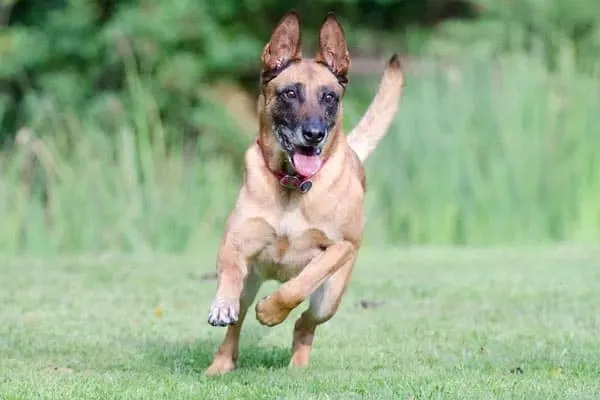
Many people mistake Belgian Malinois for German Shepherds, for they have a similar stature, including a long body, bushy tail, and similar markings.
However, the Belgian Malinois have short hair and are lighter in color than German Shepherds.
These devoted dogs love a good challenge—owners need to provide their Belgian Malinois dog with plenty of space to play and, preferably, put them to work.
As with the other shepherd dogs discussed here, the Malinois isn’t well suited for casual dog owners; they want to put their intelligence and energy to work.
The Belgian Malinois is a popular breed that the military uses, and the Navy SEAL’s Museum even has a Malinois named Raven who greets visitors.
Breeders commonly mix the Belgian Malinois with German Shepherds and other dog breeds according to the traits they want their puppies to have. Examples include:
- Corgis
- St. Bernard
- Labrador Retriever
- Dutch Shepherd
Further Reading
Are you interested in learning more about Belgian Malinois? Take a look at the following articles for more details on this loveable breed.
- Female vs. Male Belgian Malinois: Is There a Gender Difference?
- How to Calm Down a Belgian Malinois: Tips and Tricks Malinois Owners Need
- How Often Do Belgian Malinois Go into Heat: Learn Important Facts About Malinois Estrus
- Belgian Malinois Training: Why These Working Dogs Need Specialized K-9 Training
- Belgian Malinois Bark a Lot: How to Curb Excessive Malinois Barking
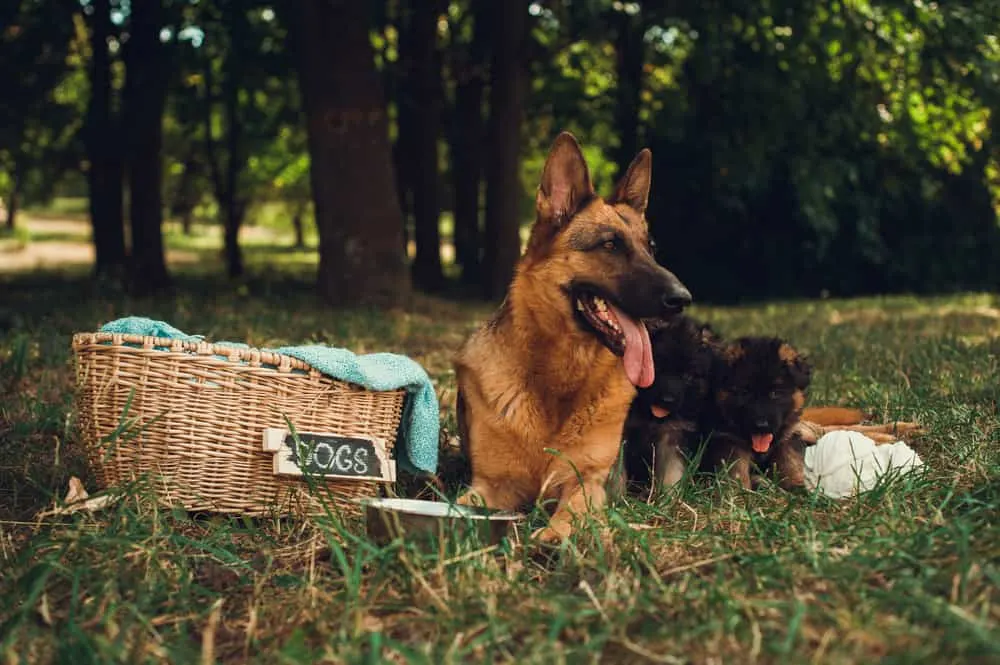
Buyer’s Guides for Products for German Shepherds
If you’re like us, your shopping list likely has as many items for your German Shepherd as it does for the humans in your household.
However, whether you want to explore a new product or switch up one you’re currently using, it’s helpful to have expert guidance from German Shepherd owners.
Below are some of our top recommended products for keeping your German Shepherd in optimal health.
The Best Nail Grinder & Nail Clipper On The Market: LuckyTail
| LuckyTail Nail Grinder | Visit LuckyTail Website | Check Price On Amazon |
|---|---|---|
 | LuckyTail.com | Amazon.com |
7 Best Dog Shampoos for German Shepherds Summer 2021
German Shepherds are work dogs, so there will likely be times when your GSD arrives at your door proudly bearing its new muddy coat.
In those moments, you need a shampoo that can cut through the thickest mud and smelliest odors.
Espree Energee Plus touts itself as being the “dirty dog” shampoo.
By harnessing degreasing properties, it’ll cut through whatever your German Shepherd rolled in, leaving behind a shiny coat thanks to its organic aloe vera.
Whether you want to give your dog a deep cleanse or a routine bath, we’ll introduce you to six other excellent shampoos as well.
6 Best Dog Muzzles for German Shepherds 2021
A muzzle isn’t something you should use on your German Shepherd 24/7.
Still, if you’re in a situation where you feel they could bite a human or another dog, it’s in the best interest of everyone to put a muzzle on them.
When choosing a muzzle, there are two must-have qualities: Comfort and a secure design so that it can’t easily be removed. For this reason, our top pick GSD muzzle is the Redline K-9.
We love how much padding this muzzle has, ensuring that no metal comes into contact with your dog’s fur.
Furthermore, the Redline K-9 has thick Latigo leather, so you can rest easy knowing your dog’s teeth won’t meet someone’s skin.
For different muzzle shapes and material options, we recommend five other excellent muzzle choices as well.
4 Best Dog Foods for German Shepherds to Gain Weight 2021
German Shepherd dogs are an active breed, so you may notice when they get too skinny.
Although we have some excellent food recommendations for increasing your dog’s weight, above all else, we recommend that you first bring your GSD to the vet.
A sudden drop in weight can be from parasites, depression, or another illness.
The best way to help a GSD gain weight is by increasing their protein and fat take. However, too much fat isn’t healthy for your dog.
For this reason, we recommend feeding your German Shepherd Blue Buffalo Wilderness Rocky Mountain Recipe.
Blue Buffalo food uses whole ingredients that naturally include 30% protein content, which makes it an excellent option for boosting weight.
For more details on our other weight-boosting GSD food recommendations, click on the heading of this section.
4 Best Haltis for German Shepherds
Due to German Shepherds having Alpha dog temperaments, it can be difficult to find the best method to walk your dog while ensuring that both you and them are comfortable and safe.
A halti is a great alternative to an around the neck leash, as it provides protection for your pup.
Haltis allow you to have more control while walking your German Shepherd without applying too much pressure to the trachea when tugged.
Because haltis are placed over the head as opposed to around the neck, they apply pressure to the dog’s shoulders when it tries to lunch, jump, or run forward.
Our top choice for the best halti is the PetSafe Gentle Leader Collar. This gentle halti combines comfort, durability, and functionality to offer you and your pup the best experience possible.
The PetSafe halti comes in an array of sizes and colors to best suit your German Shepherd.
Not only is it extremely affordable, but it is a quality product that includes a padded nose strap to minimize irritation on your dog’s sensitive skin.
The PetSafe halti is extremely versatile, and you can transform it into a regular collar that sits high on your dog’s neck for comfort when you’d prefer to use it as such.
It offers your dog full flexibility to eat, breathe, and move freely. Better yet, it comes with an instructional DVD so you can learn how to use it to its fullest potential.
The PetSafe halti is suitable for both puppies of eight weeks and adult dogs so your halti can grow with your pup.
You may need to size up as your dog grows, but with the affordable price, this shouldn’t be an issue.
6 Best Dog Foods for EPI German Shepherds 2021
Exocrine Pancreatic Insufficiency (EPI) typically affects German Shepherds when their bodies don’t have the enzymes needed to digest food properly.
Often, your veterinarian will prescribe your dog an enzyme to help them with digestion.
Other times, the condition can be managed with the support of a modified diet. In either case, we recommend six different EPI-friendly foods.
Our top pick is Diamond Naturals Premium Large Breed Formula because it contains probiotics and has a healthy balance of protein and fat.
6 Best Dog Bones for German Shepherds 2021
When your German Shepherd isn’t chasing a ball or working on your farm, he’s likely eager to have something to chew on while he “rests.”
While there are many dog bones on the market, not all are compatible with a GSD’s needs. Unfortunately, some may contain unhealthy additives or break easily under the strong jaws of your GSD.
Therefore, we cover six excellent dog bones. Our favorite is the K9 Connoisseur Single Ingredient bones, which are actually natural bones sourced from free-range cattle.
As with most high-quality foods, the K9 Connoisseur is at the pricier end of the dog bone spectrum.
However, they use the same standards for evaluating the bones as they do human food, and by making a purchase, you’ll help support their rescue organization.






















